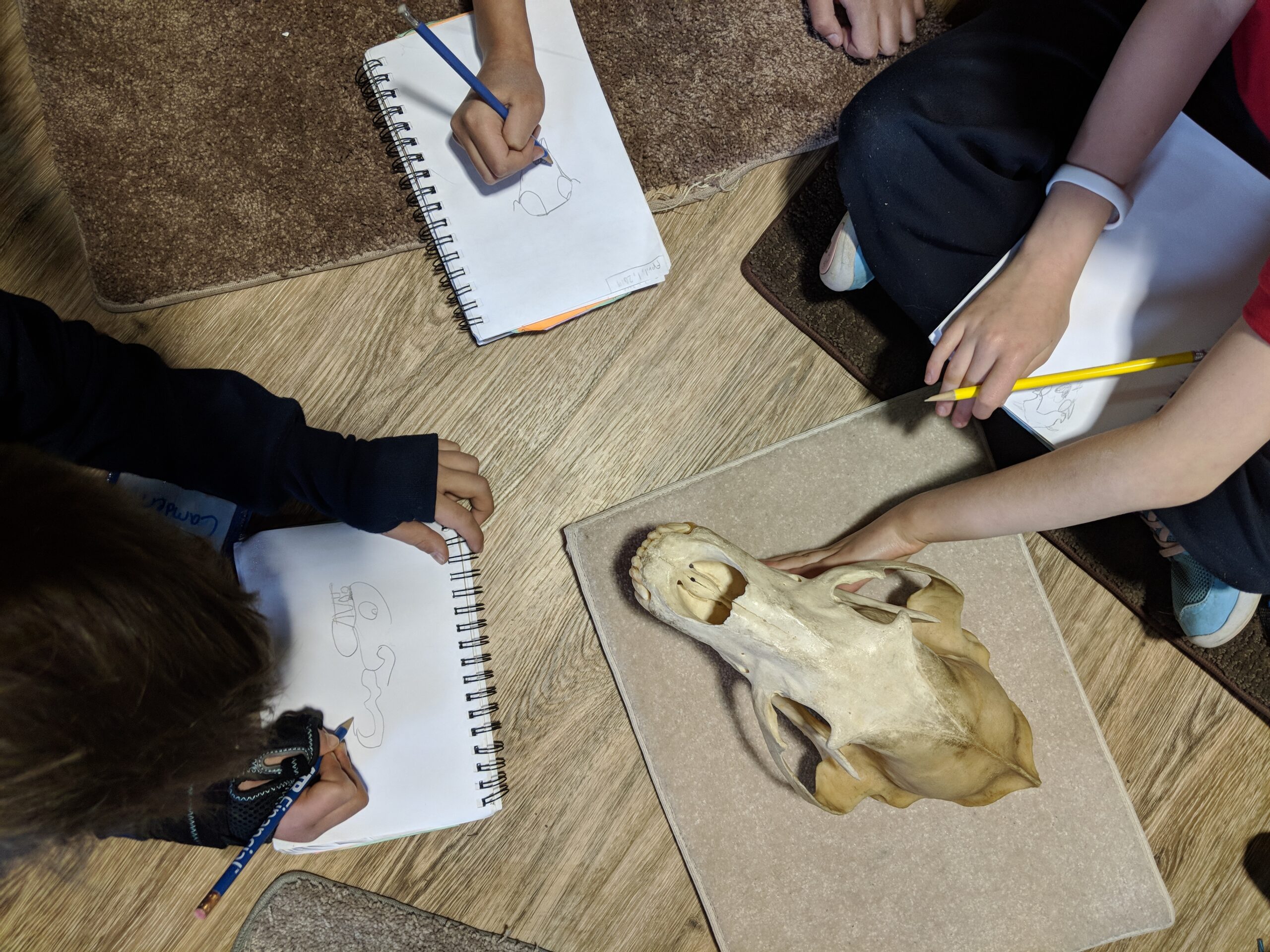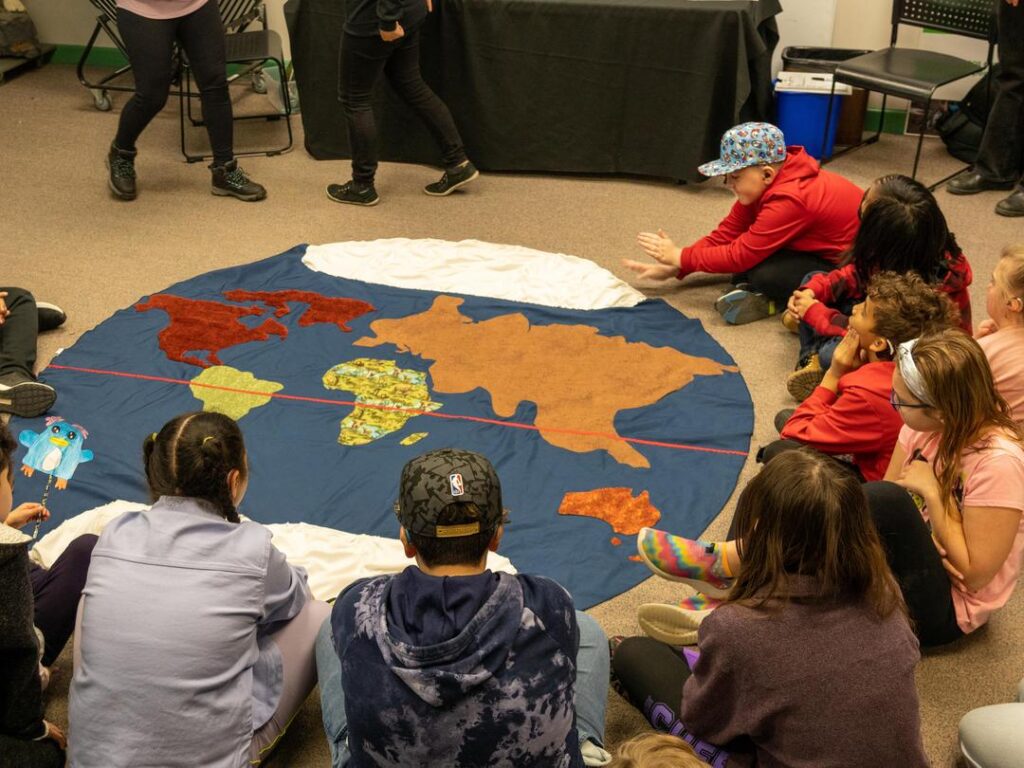
In-School Program Information
Program Information
- In-school programs are available for bookings on Mondays from December to February.
- A mileage surcharge will be applied to schools outside of Calgary city limits.
- The default booking for elementary programs is for a full day (three consecutive programs offered at one location on the same day). To book a half day (two consecutive programs offered at one location on the same day), select your program and the date and note your half day preference on the booking form.
- The default booking for secondary programs (Biodiversity, Interactions, and Ecosystems) is in pairs, with two classes receiving concurrent programs at one location on the same day. To book for one single class, select your program and the date and note your single class preference on the booking form.
- Biology 30 is only offered for a single class at a time on any given day.
Elementary Programs
Bear Necessities
Students will gain an understanding of bear species native to Canada. They will examine the question, “How do humans impact bears?” by exploring bear adaptations, their natural habitats and behaviours, and their diets. Throughout the day they will reflect on the story of the bears under human care here at the Wilder Institute/Calgary Zoo by learning about bear safety and how they can help to protect bears so that they can live in their natural environments.
Grades: Kindergarten to grade 3
Length: 60 minutes
Availability: Mondays, December to February
Capacity: Up to 27 students
Cost:
-$525 (2 programs)
-$600 (3 programs)
Curricular Connections:
Kindergarten
- Demonstrate curiosity, interest, and a willingness to learn about the environment and community
Grade 1
- Describe common living things, and identify needs of those living things
Grade 3
- Describe the appearances and life cycles of some common animals, and identify their adaptations to different environments
- Identify requirements for animal care
Develop Number Sense
- Kindergarten: Relate a numeral, 1 to 10 to its respective quantity
- Grade 1: Demonstrate an understanding of addition of numbers with answers to 20
- Grade 2: Demonstrate an understanding of addition (limited to 1- and 2-digit numerals) with answers to 100
- Grade 3: Demonstrate an understanding of multiplication to 5×5
Penguin Palooza
Students will act as conservation scientists rescuing a penguin as they move through various stations learning about adaptations, habitats, prey and predators, and family care. As students learn about penguins they will be guided to reflect on the question, “How does the Wilder Institute Calgary Zoo make a home for penguins?” to determine why zoos are important and how they can benefit our animals.
Grades: Kindergarten to grade 3
Length: 60 minutes
Availability: Mondays, December to February
Capacity: Up to 27 students
Cost:
-$525 (2 programs)
-$600 (3 programs)
Curricular Connections:
- Describe some common living things and identify the needs of those living things
- Evaluate appropriateness of various materials to the construction of watercraft
- Describe the role of insulation in keeping things hot and cold
- Identify materials that insulate animals from the cold
- Describe ways in which temperature changes affect us in our daily lives
- Describe appearances and life cycles of some common animals, and identify their adaptations to different environments
- Identify requirements for animal care
- Develop number sense:
- Kindergarten: Relate a numeral, 1 to 10, to its respective quantity
- Grade 1: Demonstrate an understanding of addition of numbers with answers to 20
- Grade 2: Demonstrate an understanding of addition (limited to 1- and 2-digit numerals) with answers to 100
- Grade 3: Demonstrate an understanding of multiplication to 5 × 5
The One & Only Ivan
Inspired by the novel “The One and Only Ivan” by K.A. Applegate, this program compares the life of Ivan from the story to our gorilla troop here at the Wilder Institute/Calgary Zoo. We will be discussing themes of the book; therefore it is best if students have finished the book or movie prior to arriving for the program. We will guide students through the process of analyzing the question, “What is the role of modern accredited zoos?” through initial brainstorming, thoughtful discussion, and observation of our gorilla troop and habitat.
Students should be familiar with the story of Ivan. Ideally classes have competed the novel, the short story book, or have watched the film. This program contains spoilers.
Grades: Grade 4 to 6
Length: 60 minutes
Availability: Mondays, December to February
Capacity: Up to 32 students
Cost:
-$525 (2 programs)
-$600 (3 programs)
Curricular Connections:
- Express ideas and develop understanding
- Use prior knowledge
- Examine the social, cultural, and linguistic characteristics that affect quality of life in communities in other parts of the world
- Describe the appearances and life cycles of some common animals, and identify their adaptations to different environments
- Experience various texts and relate texts to culture
Secondary Programs
Interactions and Ecosystems
From the tiniest puddle to the highest mountain range, our world is full of ecosystems in which plants and animals interact and survive together. In this fascinating program students will explore the impact of organisms becoming endangered or going extinct. Investigating how the Wilder Institute/Calgary Zoo contributes to wildlife conservation, students will work towards answering the question, “How might we reduce our impact on natural habitats so that we can maintain healthy ecosystems?”
Grade: 7
Length: 3 hours
Availability: Mondays, December to February
Capacity: Up to 37 students
Cost:
- $365 (1 program)
- $615 (2 programs)
Curricular Connections:
- Analyze an ecosystem to identify biotic and abiotic components, and describe interactions among these components
- Analyze ecosystems to identify producers, consumers, and decomposers; describe how energy is supplied to and flows through a food web
- Investigate a variety of habitats, and describe and interpret distribution patterns of living things found in those habitats
- Investigate and interpret evidence of interaction and change
- Identify examples of human impacts on ecosystems, and investigate and analyze the link between these impacts and the human wants and needs that give rise to them
- Identify intended and unintended consequences of human activities within local and global environments
- Describe examples of interaction and interdependency within an ecosystem
- Identify signs of ecological succession in local ecosystems
Biodiversity
Students will be investigating three different levels of biodiversity: genetic diversity, species diversity, and ecosystem diversity. As students explore the nature of reproduction, we’ll learn about the mating behaviours of some of our resident animals and examine how animals preserve biodiversity within their species. Students will learn how researchers apply this knowledge to the Species Survival Plan initiative as well as discover the science behind other captive breeding programs. Throughout the day students will reflect on the question “How might we communicate the importance of biodiversity and what actions can we take to support it?”
Grade: 9
Length: 3 hours
Availability: Mondays, December to February
Capacity: Up to 37 students
Cost:
- $365 (1 program)
- $615 (2 programs)
Curricular Connections:
- Identify impacts of human action on species survival and variation within species, and analyze related issues for personal and public decision making
- Investigate and interpret diversity among species and within species, and describe how diversity contributes to species survival
- Identify the role of variation in species survival under changing environmental conditions
- Evaluate the success and limitations of various local and global strategies for minimizing loss of species diversity
- Observe variation in living things, and describe examples of variation among species and within species
- Describe ongoing changes in biological diversity through extinction and extirpation of native species, and investigate the role of environmental factors in causing these changes
- Identify examples of niches, and describe the role of variation in enabling closely related living things to survive in the same ecosystem
Biology 30: Population and Community Dynamics
Conservation is the primary focus, drawing on important concepts such as biological and genetic diversity to better understand this complicated process. While observing some of our animals, students will discuss key terms and explore population management strategies. The students will examine the many challenges we face in conservation work by reflecting on the question “What role can society play in maintaining wildlife populations?” and apply what they have learned in class to finding solutions.
Grade: 12
Length: 3 hours
Availability: Mondays, December to February
Capacity: Up to 37 students
Cost:
- $365 (1 program)
Curricular Connections:
- Explain the basic rules and processes associated with the transmission of genetic characteristics
- Explain classical genetics at the molecular level
- Describe a community as a composite of populations in which individuals contribute to a gene pool that can change over time
- Explain the interaction of individuals in a population with one another and with members of other populations
- Explain, in quantitative terms, the change in populations over time

The Vermilion Energy Zoo Explorers Program
The Vermilion Energy Zoo Explorers program ensures all students in Calgary have the chance to experience the zoo’s unique education programs. This fund subsidizes program fees and bus services for eligible equity schools.
For the 2023-2024 school year, we have funding available for students from kindergarten to grade 6 to participate. When booking, please inquire for more details on how your students can benefit from this opportunity for on-site, in-school, or virtual programming.
On-Site and In-School Programs
Frequently Asked Questions
What can we expect from a Wilder Institute/Calgary Zoo School program?
Our school programs are developed and taught by passionate and skilled conservation educators, and are designed with 3 goals in mind:
- Engage participants in learning experiences connected to our unique setting, our animal colleagues and their conspecifics, and our global conservation programs
- Make connections that enhance Alberta Education curricular outcomes in subjects such as science, social studies, and outdoor education
- Inspire compassion and action for wildlife and wild places
What kinds of school program experiences do you offer?
Our school programming includes:
- On-site programming brings you to the zoo and features a variety of engaging lessons
- In-school programming is delivered in your own classroom
- Virtual programming brings the zoo to your learning space through unique online experiences
How many students can participate in a school program and how many chaperones are needed?
Maximum student numbers depend on the grade and program type. Check the program descriptions for specifics. In general, maximum students are as follows:
Kindergarten to grade 3: 27
Grades 4-6: 32
Grades 7-12: 37
Edu-Treks: 30
In-school programs: 1 class per program
Virtual programs: 37
Important Information
If you exceed the maximum student number permitted for your program, you must book an additional program.
- Each session includes admission for 6 adults, chaperones and teachers combined, as well as any aides required for special needs students. If you do have any aides, please let us know in advance how many will be in attendance for each session.
- No infants, toddlers, or siblings are permitted in the classroom or on tours during the formal program. Adults attending with other children will be asked to explore the zoo while the program is delivered.
- Schools must pay for any additional adults, to a maximum of 4 at a cost of $14.40 each, through Education a minimum of 3 business days prior to your visit. At the discretion of the zoo educator, these additional adults may be asked to explore on their own during the classroom portion of your visit.
Memberships and general admission do not provide access to School Programs. Any adult in the program using memberships or general day admission for the day will be asked to explore on their own during the program portion of their visit.
Adults without a pre-purchased program ticket, valid membership, or day admission ticket will be asked to leave the zoo.
Is zoo admission included in the school program cost?
Yes, you are able to explore the zoo with your class when not in your program.
How do I book and provide payment?
To book a program, click “Book Now” in the description of the selected school program and follow the directions. Programs must be booked at least two weeks before your selected program start date.
To make payment by credit card, call (403) 232-7732 at least two weeks prior to your program start date. Please note that missing this deadline will result in the cancellation of your program. You will receive a booking confirmation email once full payment is received.
Please note that we do not accept cheques or etransfers.
How do I cancel or change a program booking?
To cancel or request changes to a booked program, please call (403) 232-7732 or email SchoolPrograms@CalgaryZoo.com.
Cancellation or changes requested less than two weeks before the start of your program will incur a $50 administration fee. No refunds are granted for no-shows.
How do I provide feedback on a school program?
We welcome your feedback, as it helps us ensure that we remain as relevant and engaging as possible. You can share your thoughts with us by filling out our questionnaire.
What happens when we arrive at the zoo?
During our quieter months (September-April) you can go directly to the North Gate Entrance of the zoo. Once at the gates, let the staff know what school you are from and that you have a program. They will then send you through and onto zoo grounds.
During high season (March-June) members of our guest relations team may meet you in the North Gate bus loop or plaza and assist in directing you through the tunnel and onto the grounds. Arrival and departure at the bus loop can be busy, but we strive to support all our guests as best we can.
Once you are on zoo grounds, please explore until your program time. We recommend arriving five minutes before your scheduled start time at the location designated in your confirmation letter.
Where is my classroom located?
You can find the location of your classroom at the zoo with the map here.
Are sensory kits available?
We recognize all learners have unique learning needs. The Wilder Institute/Calgary Zoo offers sensory kits that can be used during school programs, which include learning tools such as wiggle seats, weighted stuffed animals, fidget tools, and more. Please let us know if you have student(s) who would benefit from using an item from the sensory kit by leaving a note in the comments section at checkout or by emailing SchoolPrograms@CalgaryZoo.com.
Virtual Safari Programs
What online delivery platform is used?
We deliver our Virtual Safari Programs via Zoom. Participants can join our programs on Zoom through their browser. Downloading the Zoom application is not required.
What equipment do I need to connect virtually?
If you are in a classroom or shared learning space, you will need a computer, microphone, projector, and something to project onto (screen, Smart Board, etc.).
If your students are joining from their own homes, they will need a device (computer, tablet, phone, etc.) they can view the session on.
How should we set up our learning space?
If possible, please set up your camera to show us your students, as it is much more engaging and interactive for all if the students are visible.
What online etiquette is expected of us?
We ask that you keep yourselves muted until the educator lets you know that they are ready to take your questions. Teachers may be asked to relay or repeat questions to the educator if the educator is unable to hear them.
Use the chat function only if asking or answering questions with the educator.
The teacher is responsible for the behaviour of the students.
Can we ask questions during the program?
Questions are welcomed and encouraged. Your educator will ask your class if they have questions throughout the tour.
If you are in a shared learning space, the students can come to a microphone to ask questions or the teacher can facilitate.
If students are joining from their homes, they should unmute themselves to ask a question and then mute themselves again.
The chat function can be used for questions.
Can I record a virtual session to share?
We do not permit the recording of our virtual programs.

